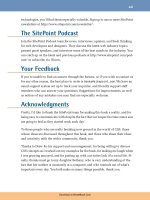The javascript anthology 101 essential tips tricks hacks - phần 8 pdf
Bạn đang xem bản rút gọn của tài liệu. Xem và tải ngay bản đầy đủ của tài liệu tại đây (310.79 KB, 16 trang )
font sizes, and content lengths, it’s often impossible to hard-code the position
of an element before you load a page. JavaScript offers a method to ascertain any
element’s position after the page has been rendered, so you can know exactly
where your elements are located.
Solution
The offsetTop and offsetLeft properties tell you the distance between the top
of an element and the top of its offsetParent. But what is offsetParent? Well,
it varies widely for different elements and different browsers. Sometimes it’s the
immediate containing element; other times it’s the html element; at other times
it’s nonexistent.
Thankfully, the solution is to follow the trail of offsetParents and add up their
offset positions—a method that will give you the element’s accurate absolute
position on the page in every browser.
If the element in question has no offsetParent, then the offset position of the
element itself is enough; otherwise, we add the offsets of the element to those of
its offsetParent, then repeat the process for its offsetParent (if any):
File: find_position_of_element.js (excerpt)
function getPosition(theElement)
{
var positionX = 0;
var positionY = 0;
while (theElement != null)
{
positionX += theElement.offsetLeft;
positionY += theElement.offsetTop;
theElement = theElement.offsetParent;
}
return [positionX, positionY];
}
IE 5 for Mac Bug
Internet Explorer 5 for Mac doesn’t take the body’s margin or padding into
account when calculating the offset dimensions, so if you desire accurate
measurements in this browser, you should have zero margins and padding
on the body.
247Order the print version of this book to get all 588 pages!
Finding the Position of an Element
Discussion
The method above works for simple and complex layouts; however, you may run
into problems when one or more of an element’s ancestors has its CSS position
property set to something other than static (the default).
There are so many possible combinations of nested positioning and browser dif-
ferences that it’s almost impossible to write a script that takes them all into ac-
count. If you are working with an interface that uses a lot of relative or absolute
positioning, it’s probably easiest to experiment with specific cases and write special
functions to deal with them. Here are just a few of the differences that you might
encounter:
❑
In Internet Explorer for Windows and Mozilla/Firefox, any element whose
parent is relatively positioned will not include the parent’s border in its own
offset; however, the parent’s offset will only measure to the edge of its border.
Therefore, the sum of these values will not include the border distance.
❑
In Opera and Safari, any absolutely or relatively positioned element whose
offsetParent is the body will include the body’s margin in its own offset.
The body’s offset will include its own margin as well.
❑
In Internet Explorer for Windows, any absolutely positioned element inside
a relatively positioned element will include the relatively positioned element’s
margin in its offset. The relatively positioned element will include its margin
as well.
Detecting the Position of the Mouse
Cursor
When working with mouse events, such as mouseover or mousemove, you will
often want to use the coordinates of the mouse cursor as part of your operation
(e.g., to position an element near the mouse). The solution explained below is
actually a more reliable method of location detection than the element position
detection method we discussed in “Finding the Position of an Element”, so if it’s
possible to use the following solution instead of the previous one, go for it!
Order the print version of this book to get all 588 pages!248
Chapter 13: Basic Dynamic HTML
Solution
The event object contains everything you need to know to work with the position
of the cursor, although a little bit of object detection is required to ensure you
get equivalent values across all browsers.
The standard method of obtaining the cursor’s position relative to the entire page
is via the pageX and pageY properties of the event object. Internet Explorer doesn’t
support these properties, but it does include some properties that are almost the
ones we want. clientX and clientY are available in Internet Explorer, though
they measure the distance from the mouse cursor to the edges of the browser
window. In order to find the position of the cursor relative to the entire page, we
need to add the current scroll position to these dimensions. This technique was
covered in Chapter 7; let’s use the getScrollingPosition function from that
solution to retrieve the required dimensions:
File: detect_mouse_cursor.js (excerpt)
function displayCursorPosition(event)
{
if (typeof event == "undefined")
{
event = window.event;
}
var scrollingPosition = getScrollingPosition();
var cursorPosition = [0, 0];
if (typeof event.pageX != "undefined" &&
typeof event.x != "undefined")
{
cursorPosition[0] = event.pageX;
cursorPosition[1] = event.pageY;
}
else
{
cursorPosition[0] = event.clientX + scrollingPosition[0];
cursorPosition[1] = event.clientY + scrollingPosition[1];
}
var paragraph = document.getElementsByTagName("p")[0];
paragraph.replaceChild(document.createTextNode(
"Your mouse is currently located at: " + cursorPosition[0] +
"," + cursorPosition[1]), paragraph.firstChild);
249Order the print version of this book to get all 588 pages!
Detecting the Position of the Mouse Cursor
return true;
}
clientX/clientY are valid W3C DOM event properties that exist in most
browsers, so we can’t rely on their existence as an indication that we need to use
them. Instead, within our event handler, we test for the existence of pageX. Inter-
net Explorer for Mac does have pageX, but it’s an incorrect value, so we must
also check for x. x is actually a nonstandard property, but most browsers support
it (the exceptions being Opera 8+ and Internet Explorer). It’s okay that Opera
8+ doesn’t support x, because the else statement is actually a cross-browser
method for calculating the mouse cursor position except in Safari, which incorrectly
gives clientX the same value as pageX. That’s why we still need to use both
methods of calculating the cursor position.
Displaying a Tooltip when you Mouse
Over an Element
Tooltips are a helpful feature in most browsers, but they can be a bit restrictive
if you plan to use them as parts of your interface. If you’d like to use layers that
appear when you want them to, aren’t truncated, and can contain more than
plain text, why not make your own enhanced tooltips?
Solution
For this example, we’ll apply a class, hastooltip, on all the elements for which
we’d like tooltips to appear. We’ll get the information that’s going to appear in
the tooltip from each element’s title attribute:
File: tooltips.html (excerpt)
<p>
These are the voyages of the <a class="hastooltip"
href="enterprise.html" title="USS Enterprise (NCC-1701) …">
starship Enterprise</a>.
</p>
From our exploration of browser events earlier in this chapter, you’ll probably
already have realized that we need to set up some event listeners to let us know
when the layer should appear and disappear.
Order the print version of this book to get all 588 pages!250
Chapter 13: Basic Dynamic HTML
Tooltips classically appear in a fixed location when you mouse over an element,
and disappear when you mouse out. Some implementations of JavaScript tooltips
also move the tooltip as the mouse moves over the element, but I personally find
this annoying. In this solution, we’ll focus on the mouseover and mouseout events:
File: tooltips.js (excerpt)
addLoadListener(initTooltips);
function initTooltips()
{
var tips = getElementsByAttribute("class", "hastooltip");
for (var i = 0; i < tips.length; i++)
{
attachEventListener(tips[i], "mouseover", showTip, false);
attachEventListener(tips[i], "mouseout", hideTip, false);
}
return true;
}
We’ve already coded quite a few of the functions in this script, including
addLoadListener from Chapter 1, getElementsByAttribute from Chapter 5,
and the attachEventListener function that we created earlier in this chapter,
so the bulk of the code is in the event listener functions:
File: tooltips.js (excerpt)
function showTip(event)
{
if (typeof event == "undefined")
{
event = window.event;
}
var target = getEventTarget(event);
while (target.className == null ||
!/(^| )hastooltip( |$)/.test(target.className))
{
target = target.parentNode;
}
var tip = document.createElement("div");
var content = target.getAttribute("title");
251Order the print version of this book to get all 588 pages!
Displaying a Tooltip when you Mouse Over an Element
target.tooltip = tip;
target.setAttribute("title", "");
if (target.getAttribute("id") != "")
{
tip.setAttribute("id", target.getAttribute("id") + "tooltip");
}
tip.className = "tooltip";
tip.appendChild(document.createTextNode(content));
var scrollingPosition = getScrollingPosition();
var cursorPosition = [0, 0];
if (typeof event.pageX != "undefined" &&
typeof event.x != "undefined")
{
cursorPosition[0] = event.pageX;
cursorPosition[1] = event.pageY;
}
else
{
cursorPosition[0] = event.clientX + scrollingPosition[0];
cursorPosition[1] = event.clientY + scrollingPosition[1];
}
tip.style.position = "absolute";
tip.style.left = cursorPosition[0] + 10 + "px";
tip.style.top = cursorPosition[1] + 10 + "px";
document.getElementsByTagName("body")[0].appendChild(tip);
return true;
}
After getting a cross-browser event object, and iterating from the base event target
element to one with a class of hastooltip, showtip goes about creating the
tooltip (a div). The content for the tooltip is taken from the title attribute of
the target element, and placed into a text node inside the tooltip.
To ensure that the browser doesn’t display a tooltip of its own on top of our en-
hanced tooltip, the title of the target element is then cleared—now, there’s
nothing for the browser to display as a tooltip, so it can’t interfere with the one
we’ve just created. Don’t worry about the potential accessibility issues caused by
removing the title: we’ll put it back later.
Order the print version of this book to get all 588 pages!252
Chapter 13: Basic Dynamic HTML
Controlling Tooltip Display in Opera
Opera still displays the original title even after we set it to an empty string.
If you wish to avoid tooltips appearing in this browser, you’ll have to stop
the default action of the mouseover using the stopDefaultAction function
from “Handling Events”, the first section of this chapter. Be aware that this
will also affect other mouseover behavior, such as the status bar address
display for hyperlinks.
To provide hooks for the styling of our tooltip, we assign the tooltip element an
ID that’s based on the target element’s ID (targetIDtooltip), and set a class
of tooltip. Although this approach allows for styles to be applied through CSS,
we are unable to calculate the tooltip’s position ahead of time, so we must use
the coordinates of the mouse cursor, as calculated when the event is triggered,
to position the tooltip (with a few extra pixels to give it some space).
All that remains is to append the tooltip element to the body, so it will magically
appear when we mouse over the link! With a little bit of CSS, it could look like
Figure 13.1.
Figure 13.1. A dynamically generated layer that appears on
mouseover
When the mouse is moved off the element, we delete the tooltip from the docu-
ment, and it will disappear:
File: tooltips.js (excerpt)
function hideTip(event)
{
if (typeof event == "undefined")
{
253Order the print version of this book to get all 588 pages!
Displaying a Tooltip when you Mouse Over an Element
event = window.event;
}
var target = getEventTarget(event);
while (target.className == null ||
!/(^| )hastooltip( |$)/.test(target.className))
{
target = target.parentNode;
}
if (target.tooltip != null)
{
target.setAttribute("title",
target.tooltip.childNodes[0].nodeValue);
target.tooltip.parentNode.removeChild(target.tooltip);
}
return false;
}
Earlier, in showTip, we created a reference to the tooltip element as a property
of the target element. Having done that, we can remove it here without needing
to search through the entire DOM. Before we remove the tooltip, we retrieve its
content and insert it into the title of the target element, so we can use it again
later.
Do those Objects Exist?
You should check that objects created in other event listeners actually exist
before attempting to manipulate them, because events can often misfire, and
you can’t guarantee that they will occur in a set order.
Discussion
One problem with the code above is that if the target element is close to the right
or bottom edge of the browser window, the tooltip will be cut off. To avoid this,
we need to make sure there’s enough space for the tooltip, and position it accord-
ingly.
By checking, in each dimension, whether the mouse position is less than the
browser window size minus the tooltip size, we can tell how far to move the layer
in order to get it onto the screen:
Order the print version of this book to get all 588 pages!254
Chapter 13: Basic Dynamic HTML
File: tooltips2.js (excerpt)
function showTip(event)
{
if (typeof event == "undefined")
{
event = window.event;
}
var target = getEventTarget(event);
while (target.className == null ||
!/(^| )hastooltip( |$)/.test(target.className))
{
target = target.parentNode;
}
var tip = document.createElement("div");
var content = target.getAttribute("title");
target.tooltip = tip;
target.setAttribute("title", "");
if (target.getAttribute("id") != "")
{
tip.setAttribute("id", target.getAttribute("id") + "tooltip");
}
tip.className = "tooltip";
tip.appendChild(document.createTextNode(content));
var scrollingPosition = getScrollingPosition();
var cursorPosition = [0, 0];
if (typeof event.pageX != "undefined" &&
typeof event.x != "undefined")
{
cursorPosition[0] = event.pageX;
cursorPosition[1] = event.pageY;
}
else
{
cursorPosition[0] = event.clientX + scrollingPosition[0];
cursorPosition[1] = event.clientY + scrollingPosition[1];
}
tip.style.position = "absolute";
255Order the print version of this book to get all 588 pages!
Displaying a Tooltip when you Mouse Over an Element
tip.style.left = cursorPosition[0] + 10 + "px";
tip.style.top = cursorPosition[1] + 10 + "px";
tip.style.visibility = "hidden";
document.getElementsByTagName("body")[0].appendChild(tip);
var viewportSize = getViewportSize();
if (cursorPosition[0] - scrollingPosition[0] + 10 +
tip.offsetWidth > viewportSize[0] - 25)
{
tip.style.left = scrollingPosition[0] + viewportSize[0] - 25 -
tip.offsetWidth + "px";
}
else
{
tip.style.left = cursorPosition[0] + 10 + "px";
}
if (cursorPosition[1] - scrollingPosition[1] + 10 +
tip.offsetHeight > viewportSize[1] - 25)
{
if (event.clientX > (viewportSize[0] - 25 - tip.offsetWidth))
{
tip.style.top = cursorPosition[1] - tip.offsetHeight - 10 +
"px";
}
else
{
tip.style.top = scrollingPosition[1] + viewportSize[1] -
25 - tip.offsetHeight + "px";
}
}
else
{
tip.style.top = cursorPosition[1] + 10 + "px";
}
tip.style.visibility = "visible";
return true;
}
This function is identical to the previous version until we get to the insertion of
the tooltip element. Just prior to inserting the element, we set its visibility to
"hidden". This means that when it’s placed on the page, the layer will occupy
Order the print version of this book to get all 588 pages!256
Chapter 13: Basic Dynamic HTML
the same space it would take up if it were visible, but the user won’t see it on the
page. This allows us to measure the tooltip’s dimensions, then reposition it without
the user seeing it flash up in its original position.
In order to detect whether the layer displays outside of the viewport, we use the
position of the cursor relative to the viewport. This could theoretically be obtained
by using clientX/clientY, but remember: Safari gives an incorrect value for this
property. Instead, we use our cross-browser values inside cursorPosition and
subtract the scrolling position (which is the equivalent of clientX/clientY). The
size of the viewport is obtained using the getViewportSize function we created
in Chapter 7, then, for each dimension, we check whether the cursor position
plus the size of the layer is greater than the viewport size (minus an allowance
for scrollbars).
If part of the layer is going to appear outside the viewport, we position it by
subtracting its dimensions from the viewport size; otherwise, it’s positioned
normally, using the cursor position.
The only other exception to note is that if the layer would normally appear outside
the viewport in both dimensions, when we are positioning it vertically, it is
automatically positioned above the cursor. This prevents the layer from appearing
directly on top of the cursor and triggering a mouseout event. It also prevents
the target element from being totally obscured by the tooltip, which would prevent
the user from clicking on it.
Measuring Visible Tooltip Dimensions
In order for the dimensions of the tooltip to be measured it must first be
appended to the document. This will automatically make it appear on the
page, so to prevent the user seeing it display in the wrong position, we need
to hide it. We do so by setting its visibility to "hidden" until we have
finalized the tooltip’s position.
We can’t use the more familiar display property here, because objects with
display set to "none" are not rendered at all, so they have no dimensions
to measure.
Sorting Tables by Column
Tables can be a mine of information, but only if you can understand them
properly. Having the ability to sort a table by its different columns allows users
257Order the print version of this book to get all 588 pages!
Sorting Tables by Column
to view the data in a way that makes sense to them, and ultimately provides the
opportunity for greater understanding.
Solution
To start off, we’ll use a semantically meaningful HTML table. This will provide
us with the structure we need to insert event listeners, inject extra elements, and
sort our data:
File: sort_tables_by_columns.html (excerpt)
<table class="sortableTable" cellspacing="0"
summary="Statistics on Star Ships">
<thead>
<tr>
<th class="c1" scope="col">
Star Ship Class
</th>
<th class="c2" scope="col">
Power Output (Terawatts)
</th>
<th class="c3" scope="col">
Maximum Warp Speed
</th>
<th class="c4" scope="col">
Captain's Seat Comfort Factor
</th>
</tr>
</thead>
<tbody>
<tr>
<td class="c1">
USS Enterprise NCC-1701-A
</td>
<td class="c2">
5000
</td>
<td class="c3">
6.0
</td>
<td class="c4">
4/10
</td>
</tr>
Order the print version of this book to get all 588 pages!258
Chapter 13: Basic Dynamic HTML
First, we need to set up event listeners on each of our table heading cells. These
will listen for clicks to our columns, and trigger a sort on the column that was
clicked:
File: sort_tables_by_columns.js (excerpt)
function initSortableTables()
{
if (identifyBrowser() != "ie5mac")
{
var tables = getElementsByAttribute("class", "sortableTable");
for (var i = 0; i < tables.length; i++)
{
var ths = tables[i].getElementsByTagName("th");
for (var k = 0; k < ths.length; k++)
{
var newA = document.createElement("a");
newA.setAttribute("href", "#");
newA.setAttribute("title",
"Sort by this column in descending order");
for (var m = 0; m < ths[k].childNodes.length; m++)
{
newA.appendChild(ths[k].childNodes[m]);
}
ths[k].appendChild(newA);
attachEventListener(newA, "click", sortColumn, false);
}
}
}
return true;
}
Internet Explorer 5 for Mac has trouble dealing with dynamically generated table
content, so we have to specifically exclude it from making any of the tables sort-
able.
Only tables with the class sortableTable will be turned into sortable tables,
so initSortableTable navigates the DOM to find the table heading cells in
these tables. Once they’re found, the contents of each heading cell are wrapped
in a hyperlink—this allows keyboard users to select a column to sort the table
259Order the print version of this book to get all 588 pages!
Sorting Tables by Column
by—and an event listener is set on these links to monitor click events, and ex-
ecute sortColumn in response. The title attribute of each link is also set,
providing the user with information on what will happen when the link is clicked.
The sortColumn function is fairly lengthy, owing to the fact that it must navigate
and rearrange the entire table structure each time a heading cell is clicked:
File: sort_tables_by_columns.js (excerpt)
function sortColumn(event)
{
if (typeof event == "undefined")
{
event = window.event;
}
var targetA = getEventTarget(event);
while (targetA.nodeName.toLowerCase() != "a")
{
targetA = targetA.parentNode;
}
var targetTh = targetA.parentNode;
var targetTr = targetTh.parentNode;
var targetTrChildren = targetTr.getElementsByTagName("th");
var targetTable = targetTr.parentNode.parentNode;
var targetTbody = targetTable.getElementsByTagName("tbody")[0];
var targetTrs = targetTbody.getElementsByTagName("tr");
var targetColumn = 0;
for (var i = 0; i < targetTrChildren.length; i++)
{
targetTrChildren[i].className = targetTrChildren[i].className.
replace(/(^| )sortedDescending( |$)/, "$1");
targetTrChildren[i].className = targetTrChildren[i].className.
replace(/(^| )sortedAscending( |$)/, "$1");
if (targetTrChildren[i] == targetTh)
{
targetColumn = i;
if (targetTrChildren[i].sortOrder == "descending" &&
targetTrChildren[i].clicked)
{
targetTrChildren[i].sortOrder = "ascending";
targetTrChildren[i].className += " sortedAscending";
Order the print version of this book to get all 588 pages!260
Chapter 13: Basic Dynamic HTML
targetA.setAttribute("title",
"Sort by this column in descending order");
}
else
{
if (targetTrChildren[i].sortOrder == "ascending" &&
!targetTrChildren[i].clicked)
{
targetTrChildren[i].className += " sortedAscending";
}
else
{
targetTrChildren[i].sortOrder = "descending";
targetTrChildren[i].className += " sortedDescending";
targetA.setAttribute("title",
"Sort by this column in ascending order");
}
}
targetTrChildren[i].clicked = true;
}
else
{
targetTrChildren[i].clicked = false;
if (targetTrChildren[i].sortOrder == "ascending")
{
targetTrChildren[i].firstChild.setAttribute("title",
"Sort by this column in ascending order");
}
else
{
targetTrChildren[i].firstChild.setAttribute("title",
"Sort by this column in descending order");
}
}
}
var newTbody = targetTbody.cloneNode(false);
for (var i = 0; i < targetTrs.length; i++)
{
var newTrs = newTbody.childNodes;
var targetValue = getInternalText(
targetTrs[i].getElementsByTagName("td")[targetColumn]);
261Order the print version of this book to get all 588 pages!
Sorting Tables by Column
for (var j = 0; j < newTrs.length; j++)
{
var newValue = getInternalText(
newTrs[j].getElementsByTagName("td")[targetColumn]);
if (targetValue == parseInt(targetValue, 10) &&
newValue == parseInt(newValue, 10))
{
targetValue = parseInt(targetValue, 10);
newValue = parseInt(newValue, 10);
}
else if (targetValue == parseFloat(targetValue) &&
newValue == parseFloat(newValue))
{
targetValue = parseFloat(targetValue, 10);
newValue = parseFloat(newValue, 10);
}
if (targetTrChildren[targetColumn].sortOrder ==
"descending")
{
if (targetValue >= newValue)
{
break;
}
}
else
{
if (targetValue <= newValue)
{
break;
}
}
}
if (j >= newTrs.length)
{
newTbody.appendChild(targetTrs[i].cloneNode(true));
}
else
{
newTbody.insertBefore(targetTrs[i].cloneNode(true),
newTrs[j]);
}
}
Order the print version of this book to get all 588 pages!262
Chapter 13: Basic Dynamic HTML









